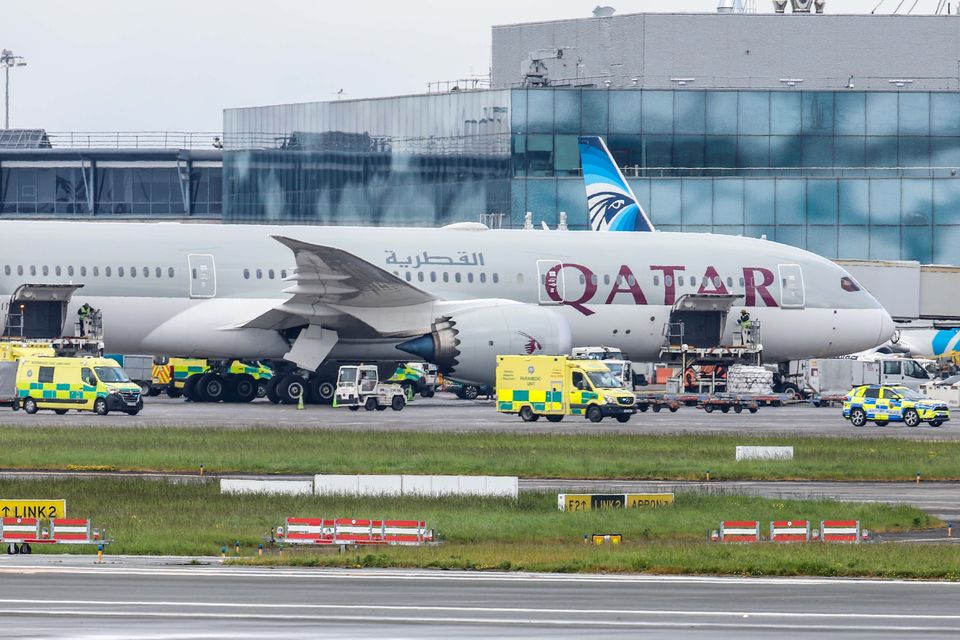Eight people hospitalised among 12 injured during turbulence on flight from Qatar to Dublin
The Qatar flight landed at Dublin Airport. Photo: Damien Storan
Dublin Airport has said eight passengers were taken to hospital after a flight from Doha experienced turbulence.
Following reports of injuries to six passengers and six crew on board the Qatar Airways flight, the airport said all passengers were assessed for injury before disembarking the aircraft, adding: “Eight passengers were subsequently taken to hospital”.
“The return flight to Doha (flight QR018) is scheduled to operate as normal this afternoon, albeit with a delay.
“Flight operations at Dublin Airport were unaffected and continue as normal this afternoon.”
Twelve people in total were injured after the Dublin-bound flight encountered turbulence over Turkey and was met by emergency services after landing in Dublin about 1pm.
Graeme McQueen, media relations manager at DAA, the operator of Dublin Airport, said its team was providing assistance to passengers and staff.
"Qatar Airways flight QR017 from Doha landed safely as scheduled at Dublin Airport shortly before 13.00 on Sunday,” he said.
"Upon landing, the aircraft was met by emergency services, including airport police and our fire and rescue department, due to six passengers and six crew [12 total] on board reporting injuries after the aircraft experienced turbulence while airborne over Turkey.
RTÉ reported that the turbulence occurred unexpectedly about two hours into the flight and that in-flight service was taking place at the time.
The plane felt as if it was “falling out of the sky” for about 15 to 20 seconds, according to RTÉ.
Last Tuesday in an unrelated incident on a flight from London, one passenger died and 30 others were injured after a Singapore Airlines encountered turbulence and was forced to land in Bangkok.
A 73-year-old British man died during the incident from a suspected heart attack while several people were critically injured, some with brain and spinal cord injuries. More than 40 people are still being treated in hospital in the Thai capital.
Singapore Airlines has changed its in-flight seatbelt rules and altered at least one flight route after the turbulence.
The airline is adopting a more cautious approach to turbulence, including not serving hot drinks or meals when the seatbelt sign is on, it said in a statement to Singapore broadcaster Channel News Asia.
"SIA will continue to review our processes, as the safety of our passengers and crew is of utmost importance," it said.
The SQ321 London-Singapore flight on a Boeing 777-300ER plane carrying 211 passengers and 18 crew diverted to Bangkok for an emergency landing on Tuesday after the plane was buffeted by turbulence that flung passengers and crew around the cabin, slamming some into the ceiling.
Singapore investigators have started examining data obtained from the cockpit voice recorder and flight data recorder, Singapore Transport Minister Chee Hong Tat said on Friday.
The daily London to Singapore route SQ321 has completed two flights since the incident and has not flown over the part of Myanmar where the sudden turbulence occurred about three hours before scheduled landing. The flight time is about the same, tracking data shows.
They flew instead over the Bay of Bengal and Andaman Sea, route data from flight tracker FlightRadar 24 showed.
Photographs from inside the plane on Tuesday showed gashes in the overhead cabin panels, oxygen masks and panels hanging from the ceiling and luggage strewn around. A passenger said some people's heads had slammed into the lights above the seats and broken the panels.
Twenty people remain in intensive care, an official at Bangkok's Samitivej Srinakarin Hospital said on Thursday.
Singapore Airlines, widely recognised as one of the world's leading carriers and seen as a benchmark for the industry, has not had any major incidents in recent years.
A spate of turbulence reports has triggered a debate over whether climate change may be causing it. A report from the University of Reading last year suggested turbulence could worsen with climate change.
Professor Paul Williams, one of the authors, said more research was needed to understand the impact of climate change on air turbulence.
Technological advances have helped limit the number of turbulence-related fatalities, which have significantly decreased in the past 20 years.
Airlineratings.com editor-in-chief Geoffrey Thomas said some airlines may change their policy on wearing seatbelts as a result of the incident.
Airlines are required by law to switch on the seatbelt sign during takeoff and landing, but carriers have their own procedures to deal with midair turbulence," Thomas said.
"I think this incident will prompt airlines, whether it's an official mandate or not. But airlines saying 'we recommend you keep your seatbelt fastened while seated', should be saying it is mandatory to keep your seatbelt done up.
The airspace over Europe has heavy traffic and the wind and weather data was often updated and shared, they said.
Join the Irish Independent WhatsApp channel
Stay up to date with all the latest news










